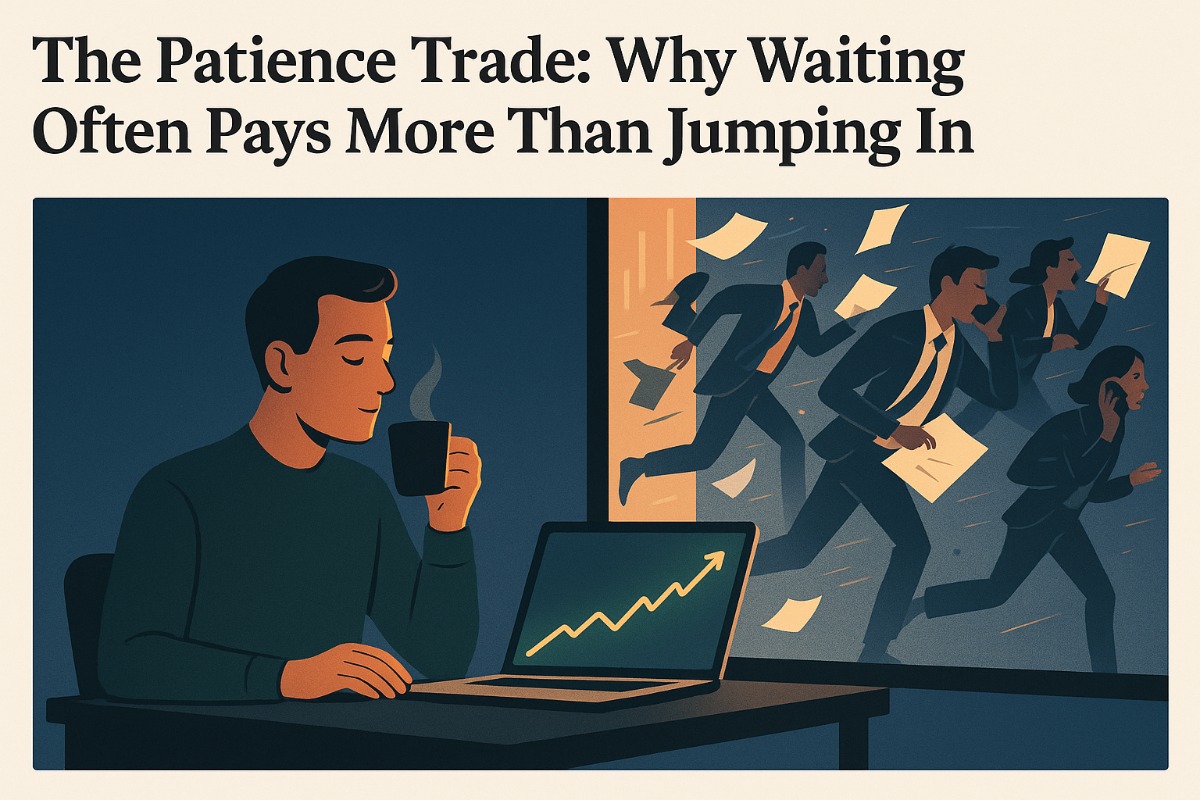Mastering the First Hour: Key Strategies to Win the Market’s Most Volatile Time
Sep 23, 2025 2:14 pm
The Patience Trade: Why Waiting Often Pays More Than Jumping In
In trading, speed is often glorified. The headlines scream about the lightning-fast moves of Wall Street firms, high-frequency trading bots, and sudden market surges that seem to come and go in seconds. Social media only fuels the fear of missing out (FOMO), showing screenshots of traders who supposedly jumped into a stock or crypto right before it exploded.
But here’s the reality most seasoned traders know: the market doesn’t reward speed nearly as much as it rewards patience. In fact, waiting-often boring, uncomfortable waiting-is one of the most underrated skills in trading.
This blog breaks down why the patience trade usually pays more than impulsive moves, and how you can train yourself to wait for the setups that truly deserve your capital.
1. Why Patience Is a Trader’s Edge
Trading is essentially the art of decision-making under uncertainty. You never have complete information. What separates consistent traders from impulsive ones is the ability to filter through noise and wait for high-probability setups.
Patience acts as a risk filter. By waiting for confirmation-whether that’s a technical pattern completing, a fundamental catalyst aligning, or market sentiment cooling down-you reduce the odds of being on the wrong side of the trade.
Think of it this way: a casino doesn’t gamble on coin flips. It waits for statistical edges. Traders should too.
2. The Cost of Jumping In Too Early
Impatience in trading often stems from FOMO. You see a chart moving and convince yourself you’ll “miss the train” if you don’t enter immediately. But what usually happens?
- You enter at the top of a short-term move, only to see the price reverse.
- You take on unnecessary drawdown, which creates emotional stress and clouded judgment.
- You burn through capital by taking low-quality trades, leaving less for the real opportunities.
The irony is that most traders would be more profitable if they simply cut their number of trades in half and only took the very best setups.
3. Case Study: The Breakout Trap
One of the clearest examples of impatience hurting traders is the false breakout.
- A stock approaches resistance.
- Social media buzz builds.
- You jump in as soon as the price pokes above the level.
But then… volume dries up, sellers push back, and the price collapses.
Impatient traders get shaken out with losses, while patient traders wait for the confirmation candle, higher volume, or retest before committing.
It’s not the breakout itself that’s the problem-it’s the timing.
4. How Professionals Use Waiting as a Weapon
Big institutions aren’t rushing in and out of every trade. They plan, scale in slowly, and often let retail traders burn themselves out chasing noise.
Patience shows up in different ways:
- Waiting for setups: Professionals have watchlists and entry criteria. If the conditions aren’t met, they simply don’t trade.
- Waiting for confirmation: Instead of guessing the bottom, they wait for higher lows and volume to confirm buyers are stepping in.
- Waiting for risk/reward: They won’t take trades where the potential profit doesn’t clearly outweigh the risk.
In other words: their money moves when the market proves it’s time, not before.
5. Training Your Patience Muscle
Patience doesn’t come naturally. In fact, markets are designed to test your discipline by moving just enough to tempt you into premature action. The good news? Patience is a skill you can build.
Here’s how:
- Define your rules. Write down your entry triggers in advance. If they aren’t met, you don’t trade.
- Use alerts. Let technology do the watching. Set price alerts instead of staring at the chart for hours.
- Focus on quality, not quantity. Track how your best trades compare to your worst. You’ll likely see that fewer trades lead to better results.
- Zoom out. Look at longer timeframes to remind yourself of the bigger picture.
- Practice sitting on your hands. Sometimes the best trade is no trade. Protecting capital is just as important as growing it.
6. The Emotional Payoff of Patience
Trading isn’t just numbers and charts-it’s emotional management. Impulsive trading creates stress, frustration, and burnout. Patience does the opposite.
When you wait for the right setups:
- You experience fewer losses, which builds confidence.
- You avoid the mental drain of constant trading.
- You feel more in control of your decisions.
- In short, patience not only improves your bottom line-it improves your mindset.
7. Final Word: Patience Is a Position
Many traders think being patient means “doing nothing.” That’s not true. Patience is an active position. It’s the discipline of choosing to wait until the odds are in your favor.
Yes, it can feel uncomfortable to sit out when others are trading. But the market isn’t a race-it’s a marathon. Waiting for quality setups, even if it means trading less, often leads to bigger wins and fewer losses.
So the next time you feel the urge to jump into a trade just because “it’s moving,” remember: the patience trade usually pays more than the rushed one.
Your capital—and your future self-will thank you.
